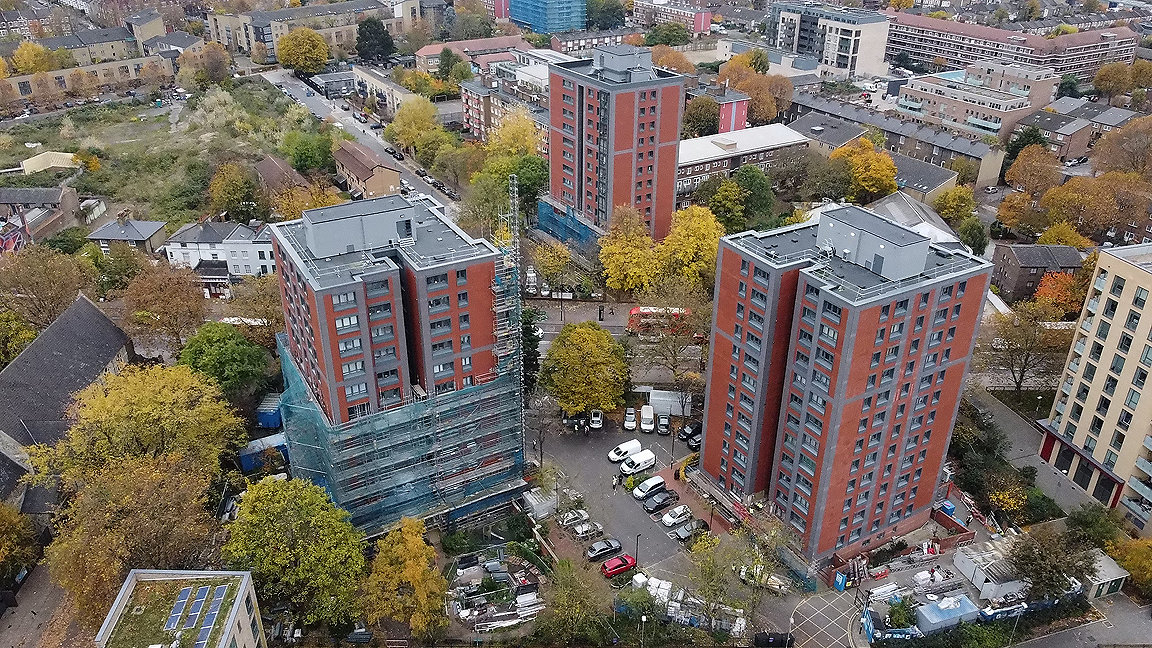
Aerial view of Hatfield Close and Gerrard House blocks in Lewisham, south London © United Living
Immediately after the tragic events of Grenfell Tower in June 2017 and the resulting government advice regarding combustible cladding on residential buildings over 18m in height, Lewisham Homes began testing all of Lewisham Council's residential high-rise blocks over 18m to assess their existing cladding systems.
Rapid response
Samples of suspected aluminium composite materials (ACMs) on each building were taken during the testing, two samples from cladding areas over 18m and two from cladding below 18m, and sent to approved testing centres. Three high-rise blocks in Lewisham Homes' housing stock – two located at Hatfield Close, as well as Gerrard House – failed the government's ACM fire combustibility tests. This raised an immediate, and potentially severe, fire safety risk.
Michael Dyson Associates Ltd, a multi-disciplinary housing consultancy firm that specialises in the social housing sector, were appointed as the lead consultant by Lewisham Homes, while social housing main contractor United Living were selected to deliver the works and provide the full delivery team for the project. 4i Solutions Ltd provided a partnering facilitator role throughout.
Project details
The three blocks are all 13 storeys high and were constructed in the 1960s. The original construction was concrete frame with brick infill sections. They appear to be very similar to each other, and are located in close proximity just off the busy A2 road in New Cross, London. However, the project team quickly began to appreciate there were a number of key differences in layout, and accurate building survey data was needed to support decision-making.
During the 1980s and 1990s, the buildings experienced weather penetration issues. In the early 2000s, a programme of improvement works took place, including the introduction of a rainscreen cladding system incorporating 100mm thick polyethylene insulation, along with extensive internal modification work via the Decent Homes Programme. The cladding installed was ACM. It incorporated a 5mm thick sheet consisting of two 1mm aluminium sheets with 3mm composite material sandwiched in between; the sheet wraps around the aluminium frame. The ACM and frame were connected to another frame, which then connected to the original brick wall. The system included 100mm thick polyethylene insulation.
The blocks are surrounded by two or three-storey buildings; the Hatfield Close and Gerrard House blocks are by far the tallest in the area. Given their prominent position on the A2 main road leading into central London, they are considered landmarks.
While the emergency stripping of the ACM cladding was being carried out by United Living from September to December 2017, wider building surveys, including structural investigations, were being carried out on the blocks to consider them holistically. It became clear to the project team that focusing solely on the emergency recladding would be short-sighted and a missed opportunity to utilise resources already working on the site. From a series of collaborative project team workshops, including representatives of Lewisham Homes, Lewisham Council, Michael Dyson Associates, United Living and residents, the Hatfield Close and Gerrard House transformation project was born.
Scope of works
Due to the accelerated nature of the project's timescales because of immediate fire safety concerns, the project execution plan – including the proposed scope of works – was developed rapidly during a series of project team workshops.
A phased delivery plan was prepared:
-
Phase 1: Removal of ACM cladding
-
Phase 2a: Making good work to original building facade and emergency fire safety works
-
Phase 2b: Enabling activities, including roof renewals and maintaining secure site, ahead of Phase 3 works
-
Phase 2c: Pre-construction design development (including planning application) and supplier procurement
-
Phase 2d: General ad hoc and/or block maintenance work
-
Phase 3a: Internal improvement works
-
Phase 3b: Recladding works
-
Phase 3c: Retrofit sprinkler installation designed and installed in accordance with British Standard 9251:2014, with sprinkler covering for all residential areas and communal areas
-
Phase 3d: Final landscaping improvements.
The primary project objective was improving the fire safety performance of the three blocks. Lewisham Homes' fire risk manager was a key member of the project team and advised throughout. Lewisham Homes were also in regular dialogue with the London Fire Brigade, including arranging site inspections during each phase of the project.
During removal of the ACM cladding, a number of unforeseen defects within the original facade of the building were discovered.
A detailed schedule of remediation works was prepared against the defects observed within the original facade, including the following:
-
Where unused kitchen heating outlets were left in situ or extraction vents had previously been removed, gaps had been left in the facade by earlier repair work with little consideration for fire safety compartmentalisation.
-
Internal area layouts had been altered during earlier refurbishment schemes and redundant openings were left untreated in the original facade, creating gaps.
-
Significant amounts of cabling, some with bare wire ends, were left behind the ACM cladding. No testing records were available, and services penetrated through walls in some areas.
-
Many unsealed ad hoc penetrations were discovered.
-
Cracking and spalling concrete was observed.
-
Tumble dryer extracts through external walls were found, which were not appropriately secured or fire stopped.
-
Ad hoc infill brickwork areas had missing and/or loose brickwork.
A series of Phase 3 scoping workshops took place, involving Lewisham Homes, Lewisham Council and resident representatives, leading to an options appraisal report being prepared and considered by the project team. Lewisham Homes were intent on successfully transforming these buildings to improve their aesthetic, structural, thermal and, not least, fire safety performance and various materials were considered for the recladding.
Through dialogue with the planners, a terracotta material was chosen due to its non-combustible A1 fire rating and robustness. As terracotta is a natural product, the tiles do not contain synthetic dyes, which means the appearance of the facade will not fade. The tiles are 30–40mm in thickness. They are restrained by clips and fixed to a support railing system. The project team decided on this option because, in addition to its essential non-combustible fire classification, a large range of tile colours, shapes, profiles and textures were available to the design team to improve the aesthetic appearance of the blocks. The life expectancy of the terracotta tiles (60 years) was also considered more favourable than other facade treatment alternatives such as render.
Internal surveys
In parallel with the ACM stripping works and the Phase 3 scoping workshops, a number of internal surveys were undertaken. The project team realised future internal improvement works would need to be carefully integrated with the new cladding system, in order to prevent similar issues to those discovered during the ACM stripping phase from occurring in the future. In order to future-proof the buildings, internal improvement works were completed at the same time as the new cladding system, and guidance for future repair and maintenance teams was prepared in order to ensure the continued performance of the new cladding system.
'In parallel with the ACM stripping works and the Phase 3 scoping workshops, a number of internal surveys were undertaken'
Project challenges
The project encountered a series of challenges, but the key solution for almost every challenge was a collaborative team approach where options were considered by a team including Lewisham Homes, Lewisham Council, their residents, Michael Dyson Associates, 4i Solutions and United Living. Creating project goals and objectives early in the project, and then undertaking regular health checks during project delivery, enabled every challenge to be resolved together.
Technical skills alone were not sufficient to deliver a project of this nature successfully, bearing in mind all three blocks had residents in situ throughout the project. Significant, joined-up workshops took place from the inception of the project and the outcomes from these were continually embedded into the project. Partnerships were formed with local resident association groups who were consulted on project decisions and made aware of improved fire safety matters throughout. A project resident liaison officer was key to fulfilling these responsibilities. The project team's contributions reached far beyond a new cladding system.
The project team realised that positive behaviours and an objective-oriented mindset would lead to a successful outcome. What began as an emergency cladding removal scheme in June 2017 developed into an award-winning project: National Building and Construction Gold Award Winner 2021. Residents, local councillors, Lewisham Homes and Lewisham Council representatives are all proud of the outcomes.
The final landscaping improvement works forming part of Phase 3d are due to be completed in the summer of 2022, with a planned project completion event inviting local councillors, residents, Lewisham Homes, Lewisham Council, Michael Dyson Associates, 4i Solutions and United Living.
Michael Brown MRICS is a director at Michael Dyson Associates
Contact Michael: Email
Related competencies include: Client care, Construction technology and environmental services, Fire safety, Legal/regulatory compliance

